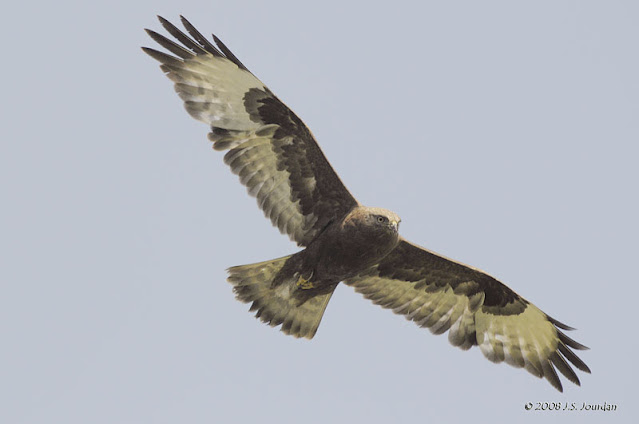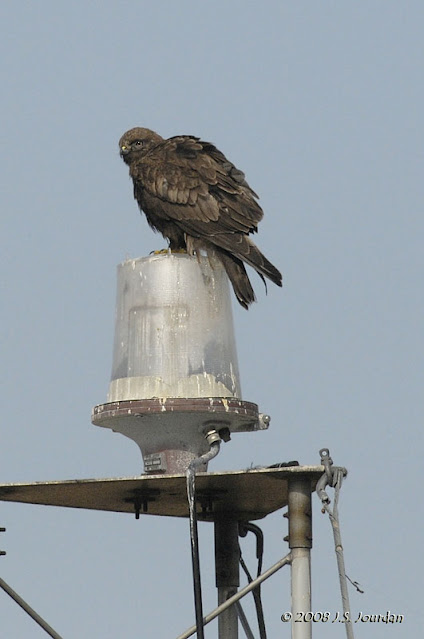Mid-May Rough-legged Hawk! - 13 May 2008
I first spotted the bird as I left the Banana Unit and headed west along the Middle Causeway. It was perched on the light tower mid-way down the path, so I left the bike and slowly walked toward it w/ the scope in front of me. Every 10 feet or so I stopped and took a couple digiscoped images before proceeding on. I was quite surprised that it allowed me to approach within about 50 yds and didn't seem alarmed. At one point it did raise up and drop scat, which normally signals that its about to fly away, but it just hopped up onto the top of the light tower and posed for several more minutes. I finally set up the scope to take a video, and within about 30 seconds it flew off toward the Vermet Unit. I was cursing myself because I couldn't focus on the bird fast enough to see what the underparts looked like. It disappeared before I could get any decent flight shots.
Returning to the bike I proceeded west along the road. Just before the marsh opens up on either side the Rough-legged Hawk flushed from the sunflower stubble to my right and proceeded to circle low over the phragmites. With the sun still somewhat low in the sky I had to wait until it circled without severe backlighting before I could snap pics w/ the D300 and Sigma 400 mm f/5.6. I was stunned that it hovered just a few feet above me, and circled for a good 5 - 10 minutes just a few feet away from me as I shot hundreds of pics at 8 fps.
At one point a male Red-winged Blackbird took offense to its presence and proceeded to mob it. I watched as the smaller bird landed on the hawk's back and proceeded to peck at its head while in flight. I got several frames showing the two birds together, so created several composite images. It was great seeing the two birds soaring low and directly toward me with outstretched wings.
After a few more circling loops it finally disappeared to the west. Satisfied that I had seen a Rough-legged Hawk I was no longer disappointed in the somewhat slow morning.
Examination of the photos show the white tail with a thick dark terminal band. However, on this bird the tail feathers were extremely worn, so the band was only slightly apparent. On a dark-phase Red-tail I would've expected to see more white blothes on the back, and more of a gray, lightly-banded tail without a dark terminal band. The beak of a Red-tail is also much heavier and more pronounced, so my ID was cinched.
Earlier in the morning I had parked at the Mouillee Creek entrance and biked in along the Middle Causeway east toward the Latenshager and Walpatch units. A thick fog blanketed the area, so I had to opt for listening to Warbling Vireos, Red-wings, Marsh Wrens, Sora, and several Swamp Sparrows. Dew-covered spider webs were everywhere, so I took the opportunity to grab a few shots against the now-waining fog.
The Lautenschlager Unit was somewhat slow. Water levels were a bit high, and the only shorebirds seen were Dunlin, Killdeer
and Spotted Sandpipers. A few Blue-winged Teal flushed in the distance, and several Mute Swans
and Great Egrets fed in the middle of the pond. A very vocal Sedge Wren sang in the cattails just across the ditch in the Bloody Run Unit, but would not appear. Common Yellowthroats and Yellow Warblers also sang.
Proceeding toward the North Causeway I stopped to scope more Dunlin,
Blue-winged Teal,
and Semipalmated Plovers, but saw little else. A Northern Harrier soared over the Vermet Unit, scattering the numerous American Coot.
I did catch a pair of Lesser Scaup along the shoreline as they swam away,
and photographed several Forster's Terns as they hovered and dove for minnows.
I walked the bike along Cell 5 and listened for passerines in the woods along the shoreline. The only birds heard were a Carolina Wren, Northern Oriole, Common Grackles, Red-winged Blackbirds, and a White-crowned Sparrow that ran along the path ahead of me. An immature Bald Eagle had flushed from its roost along the dike and soared far out over the Vermet Unit.
Stopping at Cell 3 I scoped numerous Caspian Terns, Forster's Terns, Bonaparte's Gulls, and more Dunlin. Its tough to see the birds roosting among all the garbage being dumped there. A steady stream of Forster's Terns were flying back and forth between Cell 3 and the Lead Unit, where hundreds of birds were roosting and courting.
I spent 30 minutes just watching the birds pass back and forth, and managed several fly-by shots as they passed by me and over me. Every once in a while a Bonaparte's Gull would pass overhead and allow a quick several shots.
I was able to count (6) Black Terns feeding far out in the Lead Unit, but none ever came close enough even for a distance shot. A Black-bellied Plover announced its presence with several 'Kee-er-wi' sounds as it flew direcly overhead from the Lead Unit. I managed several good frames of the mid-molting bird and produced these composites. The black armpits were quite distinctive.
Heading back down the Middle Causeway produced the Rough-legged Hawk. A small flock containing 1 Lesser Yellowlegs and 6 Short-billed Dowitchers flew past me along the shoreline and would be the only ones seen during the trip.
A Common Moorhen flushed from the Vermet Unit shoreline at the same time, so I opted for shooting the shorebirds. A pretty Pied-billed Grebe also floated away from the shoreline and allowed a few quick pics.
Pte. Mouillee SGA (permit required Sep 1-Dec 15), Monroe, Michigan, US
May 13, 2008 10:30 AM - 12:50 PM
Protocol: Traveling
5.0 mile(s)
35 species
Mute Swan (Cygnus olor) 8
Blue-winged Teal (Spatula discors) 6
Lesser Scaup (Aythya affinis) 2
Pied-billed Grebe (Podilymbus podiceps) 1
Sora (Porzana carolina) 1
Common Gallinule (Gallinula galeata) 1
American Coot (Fulica americana) 12
Black-bellied Plover (Pluvialis squatarola) 1 black armpits and "Ke-er-wi"
Killdeer (Charadrius vociferus) 2
Semipalmated Plover (Charadrius semipalmatus) 2
Short-billed Dowitcher (Limnodromus griseus) 6
Spotted Sandpiper (Actitis macularius) 2
Lesser Yellowlegs (Tringa flavipes) 1
Dunlin (Calidris alpina) 18
Bonaparte's Gull (Chroicocephalus philadelphia) 6
Caspian Tern (Hydroprogne caspia) 22
Black Tern (Chlidonias niger) 6
Forster's Tern (Sterna forsteri) 12
Great Egret (Ardea alba) 13
Northern Harrier (Circus hudsonius) 1
Bald Eagle (Haliaeetus leucocephalus) 1
Rough-legged Hawk (Buteo lagopus) 1 dark phase; small bill and white tail differentiated it from a dark morph Red-tailed Hawk. I would find it a couple days later dead in the same area of Middle Causeway next to the light tower.
Eastern Kingbird (Tyrannus tyrannus) 1
Warbling Vireo (Vireo gilvus) 2
Sedge Wren (Cistothorus stellaris) 1 sang in cattails just across ditch from bloody run unit, but would not appear. Call distinctively different from Marsh Wren. "Chip-chip-cheenk-cheenk-cheen
Marsh Wren (Cistothorus palustris) 2
Carolina Wren (Thryothorus ludovicianus) 1
Gray Catbird (Dumetella carolinensis) 1
White-crowned Sparrow (Zonotrichia leucophrys) 1
Swamp Sparrow (Melospiza georgiana) 3
Baltimore Oriole (Icterus galbula) 1
Red-winged Blackbird (Agelaius phoeniceus) 12
Common Grackle (Quiscalus quiscula) 3
Common Yellowthroat (Geothlypis trichas) 3
Yellow Warbler (Setophaga petechia) 4
View this checklist online at https://ebird.org/checklist/S4
This report was generated automatically by eBird v3 (https://ebird.org/home)
May 13, 2008 10:30 AM - 12:50 PM
Protocol: Traveling
5.0 mile(s)
35 species
Mute Swan (Cygnus olor) 8
Blue-winged Teal (Spatula discors) 6
Lesser Scaup (Aythya affinis) 2
Pied-billed Grebe (Podilymbus podiceps) 1
Sora (Porzana carolina) 1
Common Gallinule (Gallinula galeata) 1
American Coot (Fulica americana) 12
Black-bellied Plover (Pluvialis squatarola) 1 black armpits and "Ke-er-wi"
Killdeer (Charadrius vociferus) 2
Semipalmated Plover (Charadrius semipalmatus) 2
Short-billed Dowitcher (Limnodromus griseus) 6
Spotted Sandpiper (Actitis macularius) 2
Lesser Yellowlegs (Tringa flavipes) 1
Dunlin (Calidris alpina) 18
Bonaparte's Gull (Chroicocephalus philadelphia) 6
Caspian Tern (Hydroprogne caspia) 22
Black Tern (Chlidonias niger) 6
Forster's Tern (Sterna forsteri) 12
Great Egret (Ardea alba) 13
Northern Harrier (Circus hudsonius) 1
Bald Eagle (Haliaeetus leucocephalus) 1
Rough-legged Hawk (Buteo lagopus) 1 dark phase; small bill and white tail differentiated it from a dark morph Red-tailed Hawk. I would find it a couple days later dead in the same area of Middle Causeway next to the light tower.
Eastern Kingbird (Tyrannus tyrannus) 1
Warbling Vireo (Vireo gilvus) 2
Sedge Wren (Cistothorus stellaris) 1 sang in cattails just across ditch from bloody run unit, but would not appear. Call distinctively different from Marsh Wren. "Chip-chip-cheenk-cheenk-cheen
Marsh Wren (Cistothorus palustris) 2
Carolina Wren (Thryothorus ludovicianus) 1
Gray Catbird (Dumetella carolinensis) 1
White-crowned Sparrow (Zonotrichia leucophrys) 1
Swamp Sparrow (Melospiza georgiana) 3
Baltimore Oriole (Icterus galbula) 1
Red-winged Blackbird (Agelaius phoeniceus) 12
Common Grackle (Quiscalus quiscula) 3
Common Yellowthroat (Geothlypis trichas) 3
Yellow Warbler (Setophaga petechia) 4
View this checklist online at https://ebird.org/checklist/S4
This report was generated automatically by eBird v3 (https://ebird.org/home)
























































Comments
Post a Comment
Please leave a comment. I will try to respond ASAP.